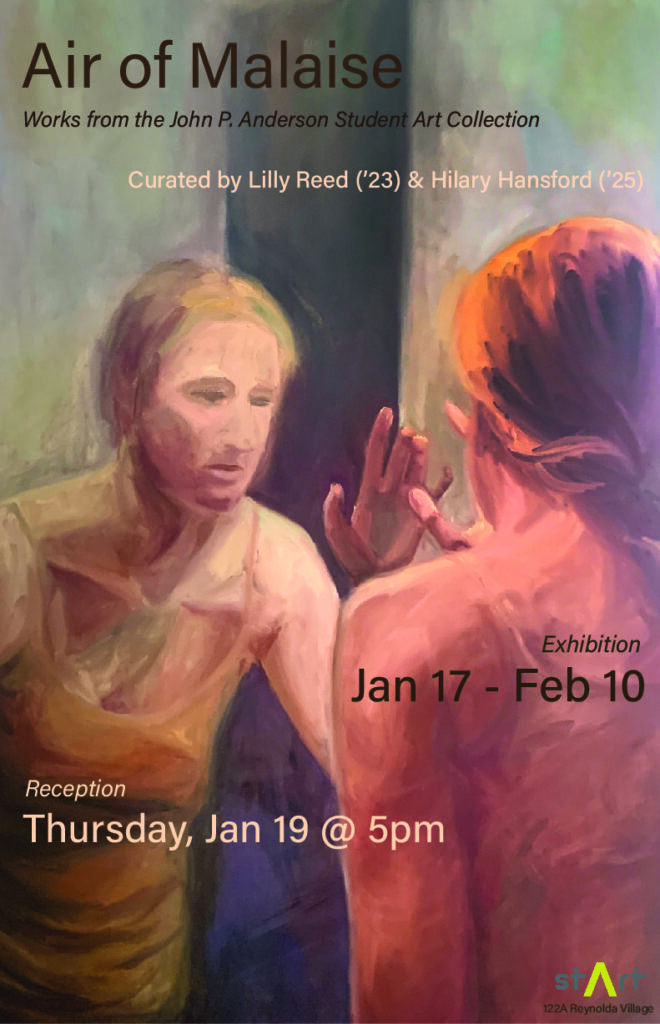Air of Malaise

Air of Malaise
Co-curated by Lilly Reed (’23) & Hilary Hansford (’25)
JANUARY 17 – FEBRUARY 10, 2023
Featuring works from the John P. Anderson Student Art Collection
stArt Gallery
Air of Malaise is co-curated by Lilly Reed and Hilary Hansford from works in the John P. Anderson Collection of Student Art, honoring its 30th anniversary and as a part of the gallery’s stArt.yourself program of student-organized exhibitions. The exhibition brings together works highlighting the connection between amorphous anxiety, trauma and their relation to where they are held in the body, placing each work in dialogue with one another as the art and artists of the collection have developed over time since 1993. Air of Malaise is derived from themes of disembodied anxiety, pressure, and unconscious tension.
In conversation with one another, these works, evoking or depicting a sense of unease, help us understand the state of being of the “student artist” and how this is transmitted through the works they create. We hope to engage our audience in understanding how malaise, stress, anxiety, and trauma can create an emotional backdrop that impacts students’ daily lives and their creative output. We hope to draw a general audience to understand how relevant trauma and stress are in people’s daily lives and how this consistently impacts the resulting ‘creative genius’.
The visual work dismantles anxiety in a way that verbal communication cannot. Art communicates pressure wordlessly, through expression, even intuitively. When art incorporates words, such as in Mitchell Anderson (‘07) Pistol and Stamen, negative words bare the language of trauma and force it into the open, making it fully conscious to us and pulling apart our preconceptions. Metaphoric language in the work’s title speaks to connections between pollination, creating fruitful life, and the killing of this life with a homonymous object, erasing life force and agency. The deliberate ambiguity of the title reflects the unease of the work’s content. Such a title engages the viewer to understand a deeper meaning behind the work.
Through gaze and introspection, we turn our attention to the Body, our and those of others. As we separate them, analyze them, break them into parts, the resulting anxiety is expressed through the work to the viewer. Without connection to the body, the parts lose their purpose. Kristina Hemphill (‘96) diptych, Standing with Carolyn and Standing with Carolyn 2, the subject’s anxieties become the viewer’s, as well. Through facial expressions and body language, we find signifiers of tension and stress. But, as a whole, a person can be deceptive in the way they express their emotions. When the body part in question is unattached like in Steven Gurysh (‘06) sculpture, the tensions and stress, still held, can no longer be contained by one person; this leaks to the viewer. Tension expressed in a dissociated part of a body compared to expression of the entire body, in areas like Katherine Lee (‘06), these disembodied parts stand in for, concentrate, and reveal the anxieties carried by the entire but only partially seen body.
Considering the works in this exhibition, in a multitude of mediums and across the multiple decades of this collection, it is hard to look at the themes of disembodied anxiety, pressure, and unconscious tension without considering the recent historical context these works were created in and the different traumas these may have produced, from the sociopolitical to the personal level, from government policy to individual experience, through open expression or repression. With the creation of these works; national and global events such as the tragedy of 9/11, the economic crash of 2008, and, most recently, the pandemic of COVID-19. In reaction to these traumas, the artists have evoked these feelings of anxiety through their art, more explicitly with pieces such as agency by Erin Cassidy (‘12) which uneasily elicits manipulative power and gender plays.
The art emerging from this general air of malaise, with its depictions, evocations and allusions, presents us with this: as people and their bodies bear the weight of anxiety and trauma, they can break down, metaphorically or actually. Parts separate from their whole and lose their purpose. Dissociated, these parts exist in isolation and in new contexts. The work of the student-artists in Air of Malaise use their work to confront these pressures and transform them through their art. Without purpose, the part exists on its own in a new context. This show also features works by William Brown (‘08), Allison Christofoli (‘96), Jennifer Gentry (‘97), Cambrey Oehler (‘12), TJ Peeler (‘03), Tracy Pu (‘16, MD ‘20), Sarah Slappey (‘06), Henry Van Pala (‘12), Quynh Vu (‘22).
____________________
Hilary Hansford is a Sophomore Art History Major with an Italian minor. She is from Dallas, Texas. At this point in her undergraduate career, she is currently interested in postmodernism, the intrinsic need humans have to be remembered, whether through their own or others’ art. Her undergraduate work in the art world includes internships with the Hanes Art Gallery working with the exhibitions of Spotlight: Katz and Copley, Liu Xia: METAPHORMS, and the upcoming Spring 2023 diverse programming of ad(d) hoc. This is her first curatorial project with the stArt Gallery.
Lilly Reed is a Senior Double Major in Sociology and Art History, from Winston-Salem, North Carolina. She is particularly interested in the intersections between sociological constructs of gender, race, and economic class on the trajectory of art history as well as the dissection of the contemporary art market. Her undergraduate work in the art world includes a summer sales internship in 2022 with Gladstone Gallery in New York City, as well as working as a gallery assistant at Hanes Gallery since 2019. She is currently an intern for the Wake Forest University Art Collection under Jennifer Finkel, curating the FOCUS gallery in Benson University center for the academic year of 2022-2023. This is her first curatorial project with stArt Gallery.
Reception
Thursday, January 19 @ 5pm

